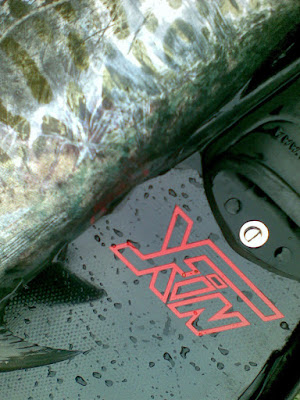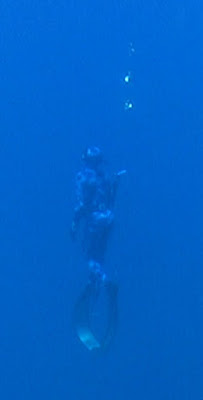 The New Xfin Composite Spearfishing Blades
The New Xfin Composite Spearfishing Blades At a Glance: Well fins are fins ..right? And you could be forgiven for for going "Nice" fins. I suppose it is very difficult to judge fins just by looking at them. The workmanship looks very good and the finish is great. But does that make a fin work?
Closer inspection reveals a slightly different rubber track running along the blade edge, the blade is also fairly wide and long. And immediately invokes all sorts of questions. Questions Steve Ellis from Fibretech is more than happy to start unravelling. He has been working on these fins for a couple years and testing a number of theories out there.
The main thing is that we have a unique way of spearfishing on the east coast. We swim through surf, land up swimming for hours against currents all while trying to spearfish. Then there are the rocks in the shore break etc. So this started to mould ... "excuse the pun" the fins into what they are.
Steve being an accomplished Spearo wanted a fin you could easily swim on the surface for hours and at the same time give the drive needed for deep dives. A common fin to date has been the imported composites which are flat and don't have an angle up at the foot pocket. The fins work well going down or off the bottom, but that is where the love affair ends. They hack on the surface and you land up having to do huge bicycle kicks to move the fins.
The Xfin has a 20 degree angle and even in very heavy / stiff blades you notice how much easier that work on the surface.
One of my first questions was " wouldn't carbon be better than glass" but after chatting to Steve and understanding his theory on his blades it makes allot of sense. Glass (plus a secret polymer resin ... Steve is not telling) fins are extremely robust and are not brittle like the carbon fins .... a plus for coming in and out the surf. But the main thing is the way the blade converts the energy or another way conserves your energy. The idea is that the blade does the work not you.
 Fist Impressions: I took a pair of Xfins on a recent trip, I chose a blade that was as stiff as the pair of imports that I currently own. Steve said I would need softer blades, but I was keen to compare apples with apples.
Fist Impressions: I took a pair of Xfins on a recent trip, I chose a blade that was as stiff as the pair of imports that I currently own. Steve said I would need softer blades, but I was keen to compare apples with apples.They were amazing, I dived 9 hours that day and even though the blades were very stiff I did not get the sore ankles and knees I was used to with my old fins. We dived mostly in water around the 18 -20m mark looking for large gamefish, and the Xfins were great in the deep.
The particular Xfins I was using were over 2 years old and you can see they had been well used, building my confidence in the promise of blades that would last.
After the trip I sent my foot pockets in to Steve and we chose a set of blades. I selected a blade that was softer than the pair I had tried. But I was still a little sceptical that the fins would preform and give me enough power of the bottom.
The Testa: I got my new Xfins yesterday arvo and decided to go and test them out. Interested to see how the lighter blades preformed. As I swam out I noticed that they were lighter, the wide blades did feel a little strange at first. I was kicking like I used to with the old flat blades and there was not same drive as before. I remembered how the pair I tried worked when using smaller movements, so I started to use smaller lighter movements and amazingly I did not slow down like I thought I would.
Overall Impressions: The concept really does work, I experimented with different strokes and it feels like I found the "sweet spot" where I was getting maximum speed out of least amount of effort. This I am sure will help with endurance on long dives allot, and help counter that fatigue that seems to make diving hard work when diving hard for a couple days in a row. So I had a great dive, and I think that with a couple more dives under the belt I will really grow into the Xfins.
In Parting: The Xfins Concept of a softer fin that through motion creates thrust works well. I think of the analogy of a Rock Cod and a Tuna fish. The Rock Cod has a larger soft tail while the Tuna a small hard tail. The Tuna is a faster fish but it vibrates its tail at a ridiculous pace to create that speed. I suppose if you think about it we are more like the old Rock Cod, and his movements are slower and more drawn out ...... and he still kicks down at a rate of knots. My point is that we would all like to be the tuna, but I think we are more like the Rock Cod.
Coatesman
